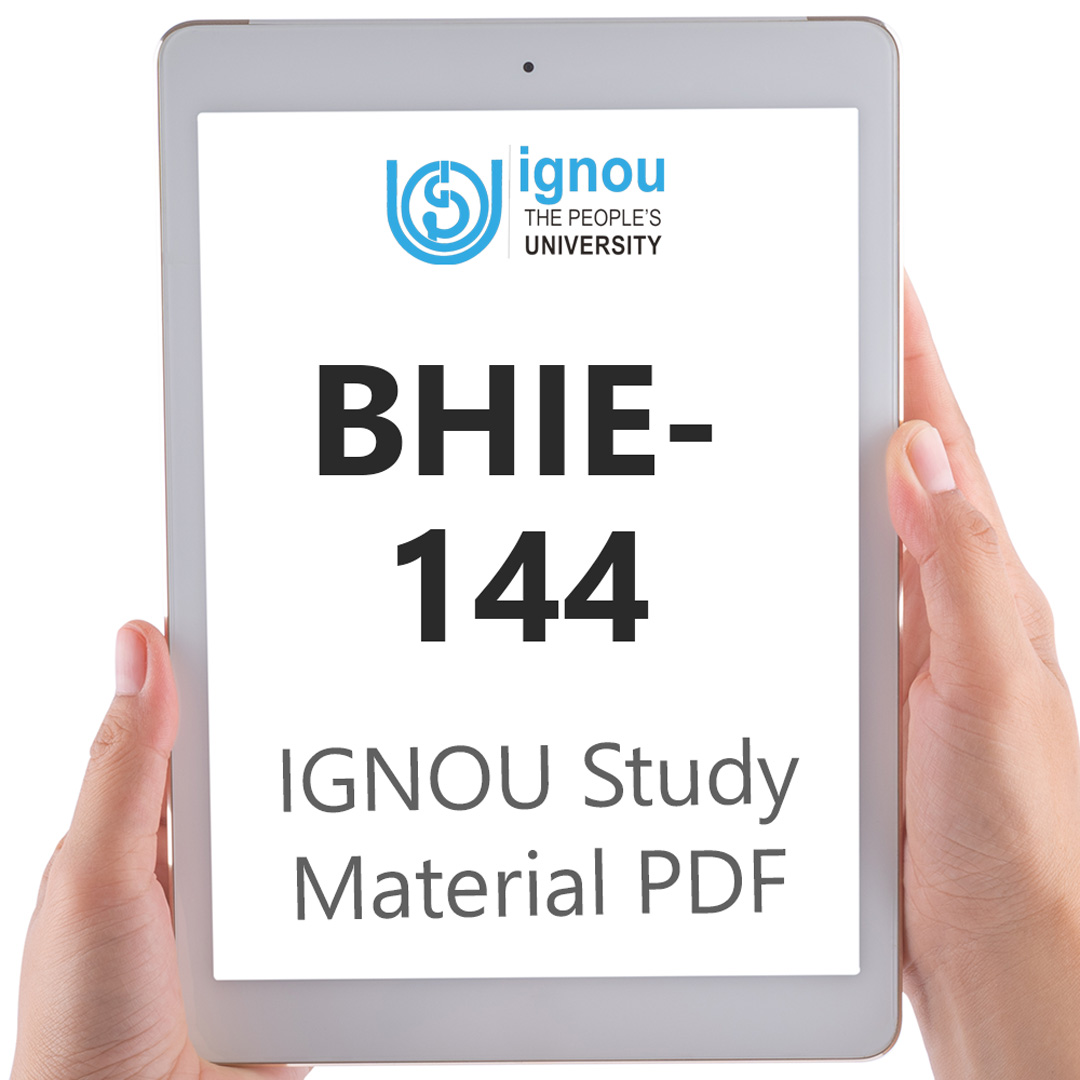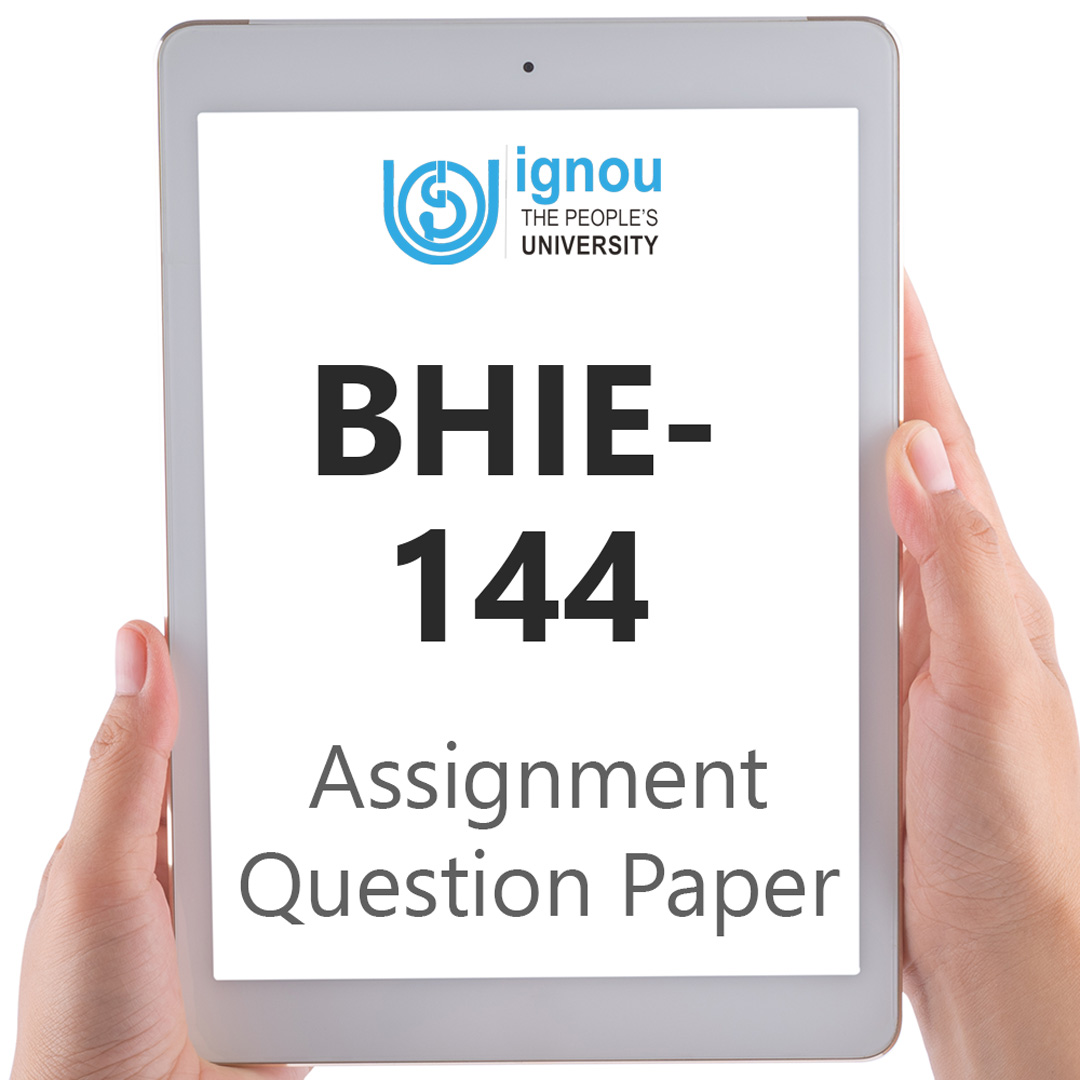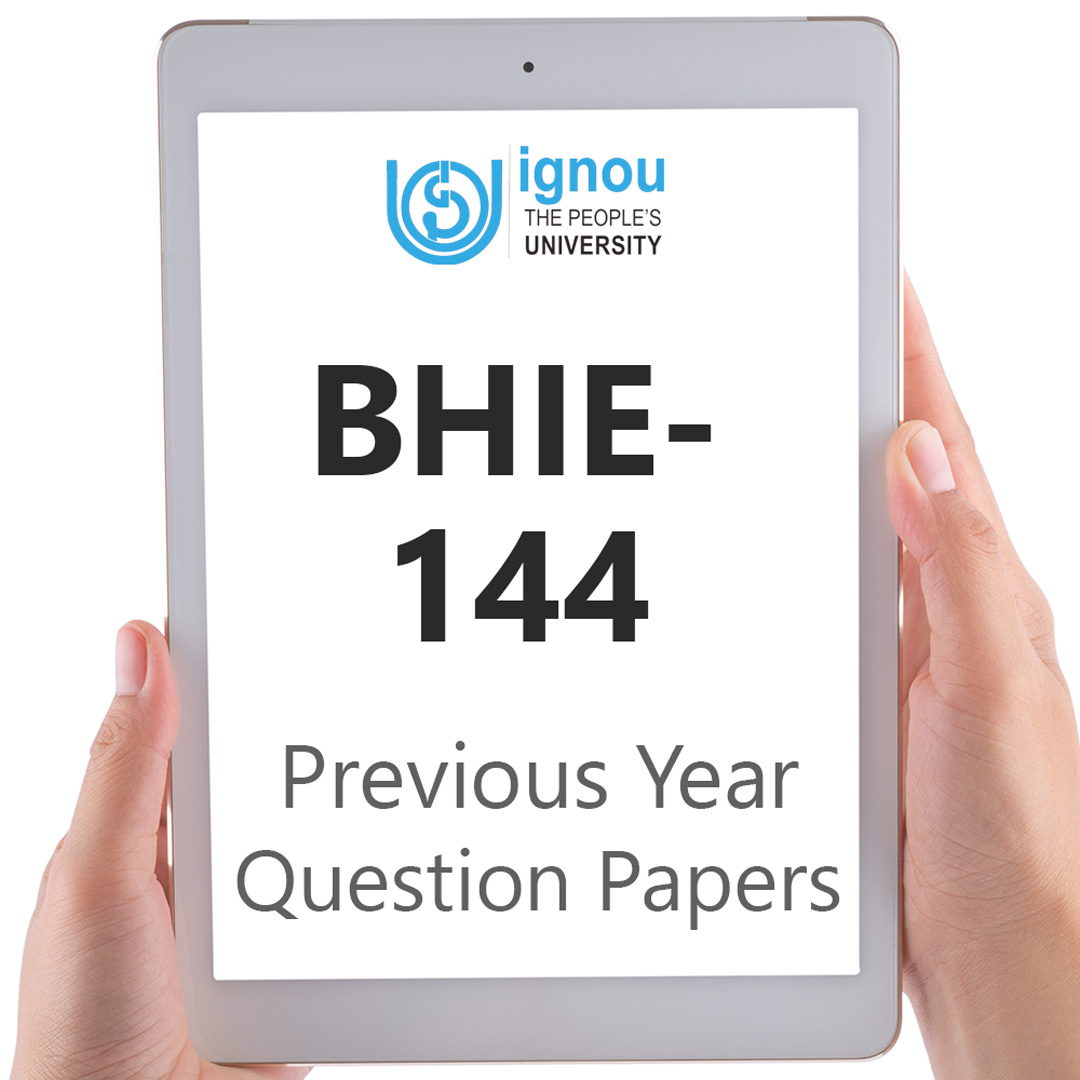If you are looking for BHIE-144 IGNOU Solved Assignment solution for the subject Financial Economics, you have come to the right place. BHIE-144 solution on this page applies to 2023-24 session students studying in BAHIH, BAG courses of IGNOU.
BHIE-144 Solved Assignment Solution by Gyaniversity
Assignment Code: BHIE-144/ASST/TMA/2023-24
Course Code: BHIE-144
Assignment Name: Traditions of History Writing in India
Year: 2023-24
Verification Status: Verified by Professor
Assignment - I
Answer the following in about 500 words each.
Q1) Explain embedded histories. Discuss how dana-stuti hymns, narasamsis and akhyans embody historical consciousness?
Ans) Embedded histories refer to historical narratives and information that are intricately woven into various forms of ancient Indian literature, such as the Vedas, epics like the Mahabharata and Ramayana, and Puranas. These texts contain a wealth of historical, social, and cultural information, often presented in the form of dana-stuti hymns, narasamsis, and akhyans. These components embody historical consciousness by providing insights into the past, offering valuable data on society, rituals, and traditions, and preserving the memory of significant events.
Dana-Stuti Hymns:
Dana-stuti hymns are verses within ancient texts that extol the virtues of giving (dana) and are often used to praise the patron who has made a donation. They are significant sources of historical information for several reasons:
a) Historical Context: Dana-stuti hymns provide information about the donor, the recipient, and the purpose of the donation. This historical context helps us understand the social and economic conditions of the time.
b) Societal Values: They reflect the societal values and norms of the era, shedding light on the importance of charity and generosity within the community.
c) Economic Practices: These hymns detail the types of gifts and offerings made, giving insights into the economy and the distribution of wealth.
d) Cultural and Religious Practices: Dana-stuti hymns often mention religious rituals and ceremonies associated with the donations, preserving information about religious and cultural practices of the time.
Narasamsis:
Narasamsis are laudatory verses or eulogies dedicated to human individuals. They serve as historical records by:
a) Preserving Biographical Information: Narasamsis narrate the life, achievements, and qualities of notable individuals, including rulers, scholars, and other prominent figures. They provide biographical details that contribute to historical reconstructions.
b) Sociopolitical Insights: These eulogies reveal information about the political landscape, patronage systems, and the relationship between rulers and poets, which helps in understanding the socio-political dynamics of the period.
c) Cultural and Literary History: They reflect the literary styles and cultural norms of the time, serving as valuable sources for understanding the literary history and aesthetic preferences of the era.
Akhyans:
Akhyans are narrative segments within texts that recount historical events or legends. They embody historical consciousness through:
a) Historical Events: Akhyans narrate specific historical events, battles, diplomatic missions, and other occurrences, providing a glimpse into the historical context.
b) Legendary Tales: Some akhyans blend history with mythology, making them culturally significant as they reinforce the interplay between the two in ancient Indian storytelling.
c) Oral Tradition: Akhyans often represent an oral tradition of passing down historical and cultural narratives, which were eventually transcribed into written texts. They preserve stories and legends that were important to the people of the time.
d) Cultural and Social Practices: These narratives reflect cultural and social practices, norms, and customs, helping us understand the way of life in ancient India.
Q2) How do bakhars help in understanding the past? Explain with examples.
Ans) Bakhars are historical narratives and records in Marathi literature that provide invaluable insights into the history, culture, and society of medieval India, particularly in the Deccan region. These texts, written by local scholars and poets, have played a crucial role in understanding the past for several reasons, offering rich historical, sociocultural, and political information.
Historical Documentation:
Bakhars serve as essential historical documents that record events, chronicles of rulers, and their administrative policies. They provide a detailed account of various periods, enabling historians to reconstruct historical timelines accurately. For example, the "Shivacharitra Mahakavya," authored by Shahaji Mahadeo Bahirat in the 17th century, narrates the achievements of Shivaji Maharaj, including his conquests and administrative reforms.
Biographical Information:
Bakhars often contain biographical information about rulers, their courts, and other influential figures of the time. These biographies offer valuable insights into their personalities, lifestyles, and the sociopolitical landscape. The "Sivadigvijay" by Paramanand Maheswari, a Marathi bakhari of the 18th century, provides a detailed account of the life and exploits of Shivaji Maharaj.
Sociocultural Context:
Bakhars provide a window into the sociocultural context of the time. They describe customs, traditions, religious practices, and daily life, allowing historians to understand the broader social fabric. For instance, the "Sabhasad Bakhar" authored by Anant Kanekar in the 18th century describes the courtly culture, festivals, and the customs of the Peshwa period.
Political Narratives:
These texts offer political narratives that reveal power struggles, diplomatic relations, and the dynamics of local and regional politics. By examining these narratives, historians can gain a deeper understanding of the political forces at play. "Chhatrapati Shivaji," a Marathi bakhari composed by Govind Pant Damle in the 19th century, provides accounts of Shivaji's political strategies and alliances.
Cultural Memory and Tradition:
Bakhars contribute to the preservation of cultural memory and tradition. They often include stories and legends, preserving a blend of historical facts and mythological elements. For example, the "Sivabharata," a 17th-century Marathi text by Krishna Bhaskar Kulkarni, incorporates mythical and legendary elements while recounting the history of Shivaji.
Linguistic and Literary Significance:
Bakhars are valuable linguistic and literary sources. They are composed in a rich and eloquent Marathi style, reflecting the literary sensibilities of their time. These texts demonstrate linguistic shifts and literary developments, providing insights into the evolution of Marathi as a language.
Local Perspectives:
Bakhars offer local perspectives, often missing in broader historical accounts. They capture regional nuances, traditions, and local lore, enhancing the depth of historical understanding. "Sangrah Shaka" by Moropant Trimbak Pingle is an example of a Marathi bakhari that focuses on the Peshwa period, presenting a unique regional perspective.
Assignment – II
Answer the following questions in about 250 words each.
Q3) What kind of historical consciousness is revealed through Sangam poems?
Ans) The Sangam poems, an ancient Tamil poetic corpus dating back over two millennia, reveal a unique historical consciousness that is characterized by a deep connection to the natural world, an emphasis on regional and local identity, and an appreciation for the societal values and cultural ethos of the time.
Nature-Centric Consciousness: The Sangam poems reflect a profound appreciation for nature, with vivid descriptions of landscapes, flora, fauna, and changing seasons. This suggests an intrinsic connection between early Tamil society and the natural environment. The reverence for the environment demonstrates an awareness of the interdependence of human life and nature.
Local and Regional Identity: Sangam poetry emphasizes a strong regional and local identity. The poems frequently mention distinct geographical locations, regional customs, and the lifestyles of various communities. This reflects a consciousness deeply rooted in regionalism and pride in local culture.
Societal Values: These poems often celebrate ideals such as love, heroism, friendship, and honour, illustrating the societal values and ethical principles of the time. This historical consciousness conveys the moral and ethical standards upheld by the ancient Tamils.
Historical Events: While not explicitly chronicling historical events, Sangam poetry indirectly references contemporary happenings and royal courts. It suggests a consciousness of the political and social dynamics of the time, with occasional allusions to wars, kings, and courtly life.
Cultural Traditions: Sangam poetry is replete with references to cultural practices, rituals, and festivities. This indicates an awareness of the cultural heritage and traditions that were an integral part of the society.
Language and Literary Evolution: The Sangam poems mark a crucial phase in the evolution of the Tamil language and literature. This historical consciousness is evident in the linguistic transitions, reflecting the changing linguistic and literary trends of the time.
Q4) Discuss Firishta’s concept of history?
Ans) Firishta, a Persian historian from the 16th and 17th centuries, approached history from a primarily religious perspective, influenced by his Islamic faith. His concept of history was rooted in the belief that historical events were manifestations of divine providence and reflected God's will. Firishta chronicled the rise and fall of dynasties and rulers in the Deccan region, providing detailed accounts of political events and administrative structures.
He followed the Persian historiographical tradition, emphasizing meticulous record-keeping and documentation. His works were written in Persian, reflecting the cultural and literary influence of Persia on the region. Firishta's historical narratives offered insights into the socio-political conditions and cultural life of the Deccan, contributing to a more comprehensive understanding of the region's history.
Q5) Write a note on nature of nationalists writings. Do you agree that nationalists’ writings emerged to counter colonial historiography?
Ans) Nationalist writings are characterized by their focus on promoting and celebrating the cultural, historical, and political identity of a nation or a specific group of people. They often emphasize the unique heritage and achievements of a nation, contributing to a collective sense of identity and pride. Nationalist writings can encompass a wide range of literary genres, including essays, poetry, historical narratives, and political manifestos.
It is true that nationalist writings frequently emerged in response to colonial historiography. Colonial historiography often depicted colonized peoples as inferior or portrayed their histories as primitive or backward. In contrast, nationalist writers sought to counter these narratives by asserting their own interpretations of history, culture, and identity. They aimed to challenge the colonial view, affirm the worthiness of their culture and history, and promote self-determination and independence.
While nationalist writings indeed emerged as a response to colonial historiography, it is essential to recognize that they were not solely reactionary but also played a crucial role in fostering a sense of national consciousness and mobilizing communities towards achieving independence and self-governance.
Assignment - III
Answer the following questions in about 100 words each.
Q6) Language of inscriptions as markers of change.
Ans) The language of inscriptions serves as crucial markers of historical change. Over time, inscriptions transition from archaic scripts to more contemporary languages, reflecting linguistic and cultural shifts. These changes are pivotal in understanding the evolution of societies, the influence of conquerors or ruling powers, and the development of written communication.
As languages evolve, inscriptions mirror the adaptation of societies to new norms and influences, becoming windows to the past that reveal shifts in power, technology, and cultural exchange, making them invaluable for historians and archaeologists in tracing the course of human history.
Q7) Paumacariyam.
Ans) The "Paumacariyam" is a Jain epic written in Ardhamagadhi Prakrit during the 10th century. It is an important text in Jain literature, particularly among the Digambara Jain tradition. The epic consists of 25 cantos and recounts the life and adventures of the 23rd Tirthankara, Parshvanatha. It narrates his birth, spiritual journey, and enlightenment. The "Paumacariyam" is not only a religious text but also a literary masterpiece, renowned for its poetic and narrative qualities. It provides valuable insights into Jain religious beliefs, rituals, and the moral and ethical teachings of Lord Parshvanatha.
Q8) Abul Fazl’s idea of history.
Ans) Abul Fazl, a prominent Mughal courtier and historian in the late 16th century, had a distinctive approach to history. His idea of history was deeply influenced by his cultural and religious background. He sought to provide an accurate and comprehensive account of the Mughal Empire, particularly during the reign of Emperor Akbar, emphasizing both political and cultural facets. Abul Fazl's work, "Akbarnama," is not merely a chronicle but an intricate synthesis of history, culture, and politics, reflecting his belief in the importance of enlightened rule, tolerance, and administrative efficiency, which he saw as central to Akbar's reign.
Q9) Labour Histories.
Ans) Labour histories are a branch of historical scholarship that focuses on the experiences, struggles, and contributions of the working class. These histories examine the social, economic, and political aspects of labour, tracing the evolution of labour movements, unions, and workers' rights over time. They shed light on issues like labour exploitation, workplace conditions, and the fight for better wages and working conditions.
Labour histories provide valuable insights into the development of the labour force, its role in shaping industrial societies, and the broader socioeconomic changes driven by the labour movement, making them essential for understanding the dynamics of labour and social justice.
Q10) Ranajit Guha.
Ans) Ranajit Guha is an eminent Indian historian known for his pioneering work in the field of Subaltern Studies. Born in 1923, he is celebrated for his influential contributions to postcolonial historiography. Guha's work is characterized by a focus on marginalized and subaltern groups, shedding light on their historical agency and resistance in the context of colonial rule.
His book, "Elementary Aspects of Peasant Insurgency in Colonial India," is a seminal work in this regard. Guha's scholarship has significantly impacted the study of Indian history and inspired a generation of historians to explore the voices and agency of the subaltern in historical narratives.





